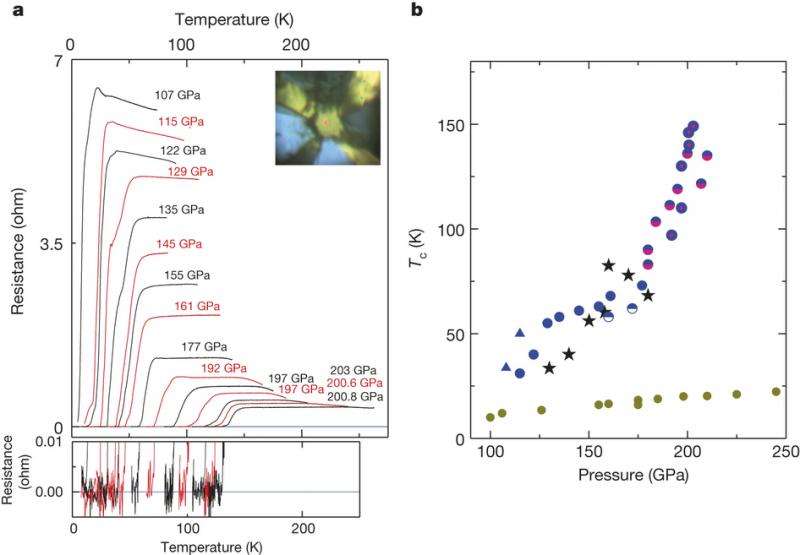August 19, 2015 report
Researchers set new temperature record for a superconductor

(Phys.org)—A combined team of researchers from the Max Planck Institute and Johannes Gutenberg-Universität Mainz has set a new warmth record for a superconductor. In their paper published in the journal Nature, the team describes the process they followed that led to the record and why it gives them optimism regarding the possibility of ever finding a superconductor that works at room temperature. Igor Mazin, with the Naval Research Laboratory in Washington, offers a News & Views piece on the work done by the team in the same journal issue, suggesting that the new record is causing some disbelievers to become more optimistic that the holy grail of superconductors will someday soon be found.
During normal electrical conduction, electrons run into ions causing a ricochet and loss of energy. But scientists have also noted that such collisions also lead to the generation of small clusters of positive charge, which can lead to the formation of Cooper's pairs—that is a good thing, because such pairs are less likely to be part of future collisions. The net result is better efficiency. But, sadly, such pairings are weak, which means they are easily knocked apart by thermal energy—thus, colder temperatures allow for longer lasting Cooper's pairs and better efficiency, and that is why superconductors work at cold temperatures. But scientists are hopeful that one day a material will be found that allows for super-conduction at room temperature. In this new effort, the researchers have taken the science one step further.
They put a specimen of hydrogen sulphide into a diamond anvil to pressurize it to approximately 1.6 million times that of atmospheric pressure and then cooled it down to just -70 °C—under such conditions hydrogen sulphide becomes a metal, and in this case, one that is superconducting. What is exciting about this latest record is that the temperature used in the experiment, actually occurs naturally on the surface of our planet sometimes—in Antarctica. That gives researchers the feeling that the next team of record breakers (perhaps using another hydrogen compound) is liable to get even closer, and that eventually, specimens will not have to be cooled at all. Theoretically, the team notes, there is nothing that forbids their existence.
More information: Conventional superconductivity at 203 kelvin at high pressures in the sulfur hydride system, Nature (2015) DOI: 10.1038/nature14964
Abstract
A superconductor is a material that can conduct electricity without resistance below a superconducting transition temperature, Tc. The highest Tc that has been achieved to date is in the copper oxide system1: 133 kelvin at ambient pressure2 and 164 kelvin at high pressures3. As the nature of superconductivity in these materials is still not fully understood (they are not conventional superconductors), the prospects for achieving still higher transition temperatures by this route are not clear. In contrast, the Bardeen–Cooper–Schrieffer theory of conventional superconductivity gives a guide for achieving high Tc with no theoretical upper bound—all that is needed is a favourable combination of high-frequency phonons, strong electron–phonon coupling, and a high density of states4. These conditions can in principle be fulfilled for metallic hydrogen and covalent compounds dominated by hydrogen5, 6, as hydrogen atoms provide the necessary high-frequency phonon modes as well as the strong electron–phonon coupling. Numerous calculations support this idea and have predicted transition temperatures in the range 50–235 kelvin for many hydrides7, but only a moderate Tc of 17 kelvin has been observed experimentally8. Here we investigate sulfur hydride9, where a Tc of 80 kelvin has been predicted10. We find that this system transforms to a metal at a pressure of approximately 90 gigapascals. On cooling, we see signatures of superconductivity: a sharp drop of the resistivity to zero and a decrease of the transition temperature with magnetic field, with magnetic susceptibility measurements confirming a Tc of 203 kelvin. Moreover, a pronounced isotope shift of Tc in sulfur deuteride is suggestive of an electron–phonon mechanism of superconductivity that is consistent with the Bardeen–Cooper–Schrieffer scenario. We argue that the phase responsible for high-Tc superconductivity in this system is likely to be H3S, formed from H2S by decomposition under pressure. These findings raise hope for the prospects for achieving room-temperature superconductivity in other hydrogen-based materials
Journal information: Nature
© 2015 Phys.org



















